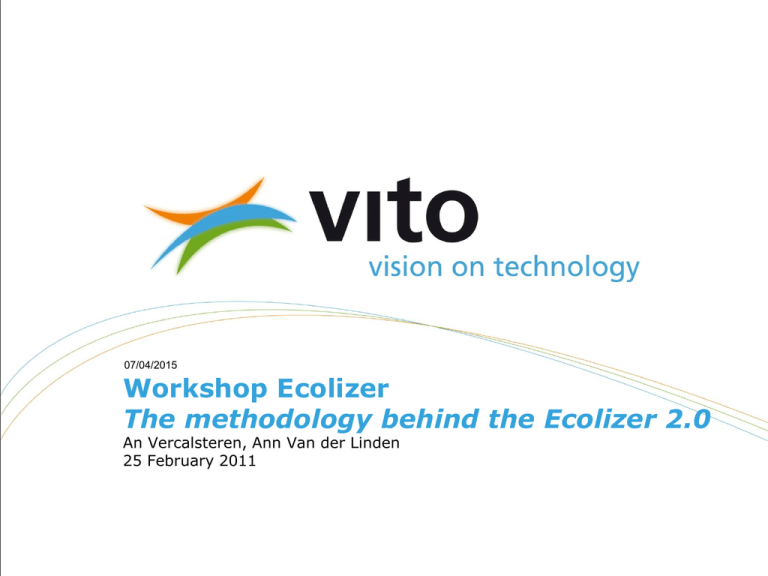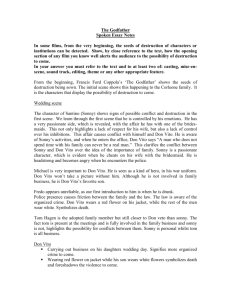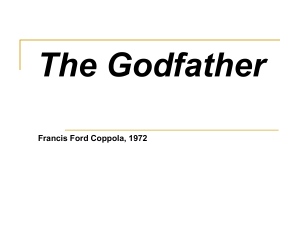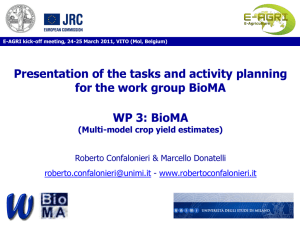
07/04/2015
Workshop Ecolizer
The methodology behind the Ecolizer 2.0
An Vercalsteren, Ann Van der Linden
25 February 2011
Outline
»
»
»
»
Introduction
Method for calculating the eco-indicators
Data sources
Points of attention
» End of Life
» Recycling
» Questions
07/04/2015
© 2009, VITO NV – All rights reserved
2
Introduction
» Ecolizer
» Sheets with eco-indicators (EI)
» Measure for environmental impact
» Expressed in mPt/unit (kg, m, m², tonkm,
etc)
» Higher EI higher environmental impact
» Basis = LCA
» Integral environmental impact
» Life cycle perspective
» LCI data
07/04/2015
© 2009, VITO NV – All rights reserved
3
Introduction
» Ecolizer 1.0 versus 2.0
» Update method for calculation of eco-indicators
» ReCiPe method instead of Eco-Indicator 99
method
» Update LCI-databases
» More data available
» Materials
» Processes
07/04/2015
© 2009, VITO NV – All rights reserved
4
Method for calculation of eco-indicators
» Ecolizer 1.0
» Eco-Indicator 99 method
» Developed in 1999
» No future updates
» Alternative method for update Ecolizer 2.0:
» ReCiPe
» Scientific basis
» Successor of EI-99 method
» Recently developed
07/04/2015
© 2009, VITO NV – All rights reserved
5
Method for calculation of eco-indicators
» ReCiPe
» Developed by Pré Consultants and CML (2009)
» Combination of EI-99 and CML 2001 method
» 3 steps:
» Environmental impact categories (midpoint)
» E.g. Climate change, acidification
» Environmental damage categories (endpoint)
» E.g. Damage to human health
» One environmental indicator: eco-indicator
07/04/2015
© 2009, VITO NV – All rights reserved
6
Method for calculation of eco-indicators
» ReCiPe – environmental impact categories
(midpoint)
»
»
»
»
»
»
»
»
»
»
»
Climate change
Ozone layer depletion
Acidification
Eutrophication (freshwater)
Human toxicity
Photochemical oxidant formation
Particulate matter formation
Ecotoxicity (terrestrial, freshwater, marine)
Ionizing radiation
Land use (agricultural, urban)
Depletion of resources (metals, fossil)
07/04/2015
© 2009, VITO NV – All rights reserved
7
Method for calculation of eco-indicators
» ReCiPe – environmental damage categories
(endpoint)
» Damage to human health
» Damage to ecosystems
» Depletion of resources
Enviromental damage
category
Weighting factor
(Hierarcist/Average)
Human health
400
Ecosystems
400
Resources
200
07/04/2015
© 2009, VITO NV – All rights reserved
8
07/04/2015
© 2009, VITO NV – All rights reserved
9
Comparison EI-99 and ReCiPe
Metals (Source: Pré Consultants, LCM2009 conference)
07/04/2015
© 2009, VITO NV – All rights reserved
10
Comparison EI-99 and ReCiPe
Transport (Source: Pré Consultants, LCM2009 conference)
07/04/2015
© 2009, VITO NV – All rights reserved
11
Comparison EI-99 and ReCiPe
Energy (Source: Pré Consultants, LCM2009 conference)
07/04/2015
© 2009, VITO NV – All rights reserved
12
Comparison EI-99 and ReCiPe
Processes (Source: Pré Consultants, LCM2009 conference)
07/04/2015
© 2009, VITO NV – All rights reserved
13
Comparison EI-99 and ReCiPe
Biofuels (Source: Pré Consultants, LCM2009 conference)
07/04/2015
© 2009, VITO NV – All rights reserved
14
Comparison EI-99 and ReCiPe
» Difference between eco-indicator score according to EI-99
and ReCiPe method
» Relative difference is not always consistent
» Order of ranking and ratio remain more or less the
samen when comparing different materials/processes
» Due to higher characterisation factors for a.o. DALY
versus CO2-equivalents
V g l E I-9 9 v s . R e C iP e _ e x c l. L E D
0 ,3
E I-99
0 ,2 5
R eC iP e
0 ,2
0 ,1 5
0 ,1
0 ,0 5
© 2009, VITO NV – All rights reserved
U
T r a n s p o r t,
fr e ig h t, r a il/R E R
> 1 6 t, fle e t
a v e r a g e /R E R S
T r a n s p o r t, lo r r y
v o lta g e ,
p r o d u c tio n R E R ,
a t g r id /R E R S
E le c tr ic ity , lo w
g r id / B E S
v o lta g e ,
07/04/2015
p r o d u c tio n B E , a t
E le c tr ic ity , lo w
B r ic k , a t
p la n t/R E R U
p la n t/R E R U
g r a n u la te , a t
P o ly p r o p y le n e ,
s to r a g e /R E R U
P o ly v in y lc h lo r id e ,
a t r e g io n a l
0
15
Data sources
» LCI-database for background data
» Ecoinvent 2.0 database (update)
» Extended with a.o. biomaterials
» Ecoinvent 1.0 used for Ecolizer 1.0
» Additional data from Pré Consultants
07/04/2015
© 2009, VITO NV – All rights reserved
16
Data sources
» Data quality:
» Black:
» Based on reliable data
» Grey:
» Based on limited dataset
» Less reliable
» ! Exclamation mark:
» Uncertain, based on estimations
» generic data, not specific for the material
07/04/2015
© 2009, VITO NV – All rights reserved
17
Points of attention
End of Life
» Per material sheet:
» Recycling
» Impact of recycling process
» Credits of avoided material production
» Total
» Waste scenario EU
» 80% disposal – 20% incineration
07/04/2015
© 2009, VITO NV – All rights reserved
18
Points of attention
EoL - incineration
» Only combustible flows go to incineration: no
indicator for incineration of ferro, non ferro
and inert materials
» Own calculations
» Emissions and avoided emissions to air,
auxiliary materials taken into account
» Type of energy: electricity
07/04/2015
© 2009, VITO NV – All rights reserved
19
Points of attention
Recycling
» 2 approaches:
» “recycled content approach”
» Take into account the effective input of recycled
material
» Use indicator for production of recycled material
» NO recycling at end of life
» “end of life recycling approach”
» Take into account the recycling scenario at end of life
» Use indicator for recycling process
» NO input of recycled material
07/04/2015
© 2009, VITO NV – All rights reserved
20
Questions?
An Vercalsteren
VITO
An.vercalsteren@vito.be
07/04/2015
© 2009, VITO NV – All rights reserved
21










